IN TIME TO COME, 2017, dir Tan Pin Pin
For over 15 years, Singaporean filmmaker Tan Pin Pin has been a meditative, pointed and courageous documentarian of the submerged histories and bittersweet textures of the ultramodern, authoritarian city-state she calls home. Much of the power of her work comes from her unearthing and drawing out of compelling personalities, from the ragtag buskers, entertainers and public announcers who make up the soundtrack of everyday life in Singapore GaGa (2005), to the political exiles scattered across the globe in To Singapore, with Love (2013), a feature that has won awards at film festivals in Busan and Dubai but remains banned from public screenings at home. Think layered narratives, offset by unembellished camerawork and a reliance on diegetic or natural sounds.
In her latest documentary feature, IN TIME TO COME (2017), Tan shifts her focus from characterisation to crowds, in search of an alternative cinematic language. A depiction of mundane, easily overlooked rituals of Singaporean life – from mosquito fogging at a condominium to the shutters of a big Japanese-owned bookstore coming up in the morning and its staff bowing to greet the first customers – IN TIME TO COME is a general wash of crowd and group scenes shot in very long, still takes, the camera keeping its distance and rarely picking out specifc individuals or moments. Initially underwhelming and seemingly devoid of the narrative urgency underscoring Tan’s best work, the film grew on me. It becomes clear, from the scenes of time capsules being packed and sealed, or dug up and opened, that this footage of present-day Singapore constitutes an archive of sorts for future generations. In a question-and-answer session following the screening I attend, Tan reveals that the film was shot over the period of the country’s Golden Jubilee in 2015, when there was no shortage of ceremonies and unveiling of time capsules, but that she chose to capture the most banal aspects of these.
The 62-minute film settles into a rhythm, by turns predictable and quietly illuminating. At an appreciation dinner marking SG50 (the ubiquitous official shorthand for that Jubilee year), it quickly becomes apparent that Tan will show people waiting for the guest of honour though not the guest’s actual arrival. But the camera stays trained on this group long enough for a civil servant to drop her staff pass and for the viewer to notice it before she does. Accidents are minor; there are no major disruptions. The viewer of IN TIME TO COME alternates between crying out for a little drama to finding pathos or strangeness in the ordinary. South Asian construction workers stare at the stump of a huge banyan tree, the chopping of which has been a major operation, with all the chainsaws and bulldozers assembled. At a fire drill in a school, a disembodied voice blares over a klaxon: “It could happen anywhere, not just in a school”. One frame is filled entirely with fog, before it clears and the outlines of cars in a carpark being fumigated slowly become visible. Tan makes these wry asides on the machinery of containment in a city obsessed with order and hygiene, as well as the humanity that courses beneath the surface.
It is one closeup, however, that for me provided the most poignant moment of the film. In a scene where objects from a time capsule from the year 1990 are laid out, the gloved hands of a museum worker are shown thumbing through the crisp pages of a phone directory. I realised with a jolt that I hadn’t seen one of those in years, but it was a sight so well-worn and familiar. In the public post film conversation, Tan said her inspiration was the extraordinary archive of the late Ivan Polunin, who, together with his reels of film footage of pre-independence Singapore, featured as one of the makers and seekers of the country’s past in her riveting feature Invisible City (2007). Out of his more-than- 30 hours of footage, what stayed with her was a scene in a wet market of policemen chasing illegal hawkers. She made the telling observation that, correspondingly, what could strike someone 50 years from now about Singapore today could be just as personal and unexpected. Seen in that light, hers is ultimately a film for the future. Like the visceral reaction I got from the sight of a 25-year-old phonebook, perhaps this is a work best savoured in time to come, rather than in the here and now.
From the Winter 2017 issue of ArtReview Asia
